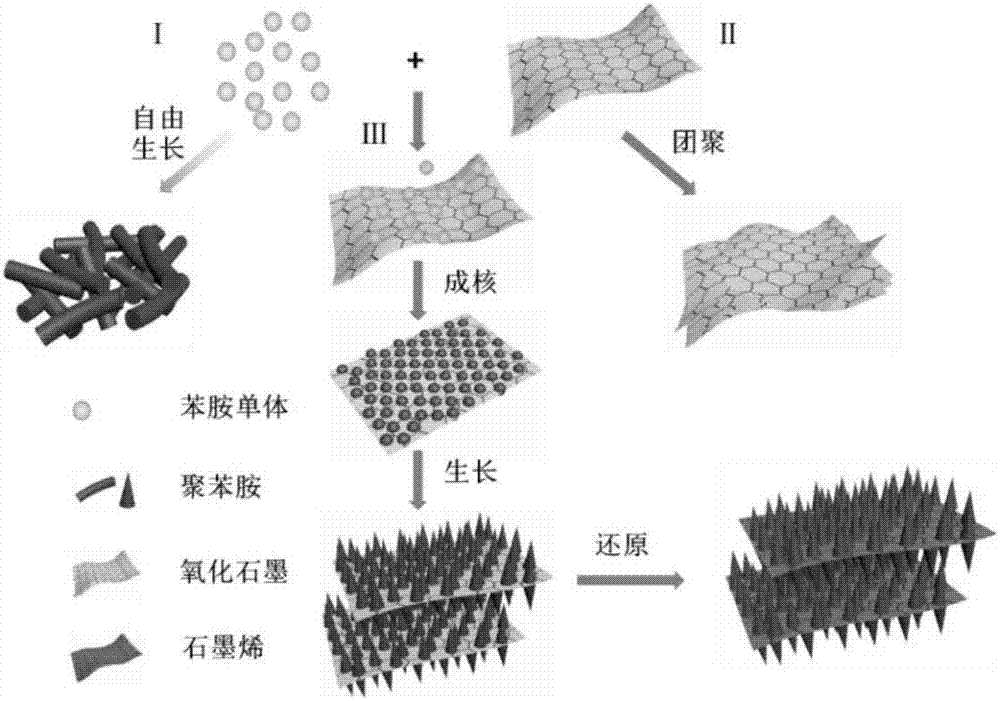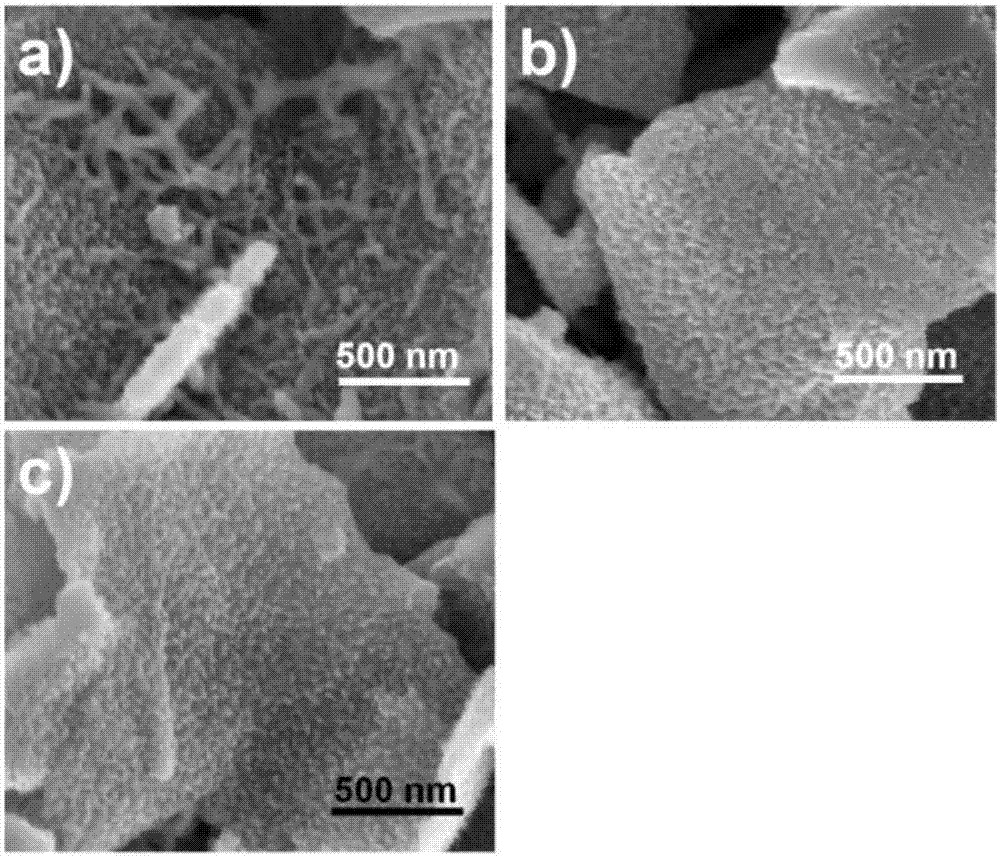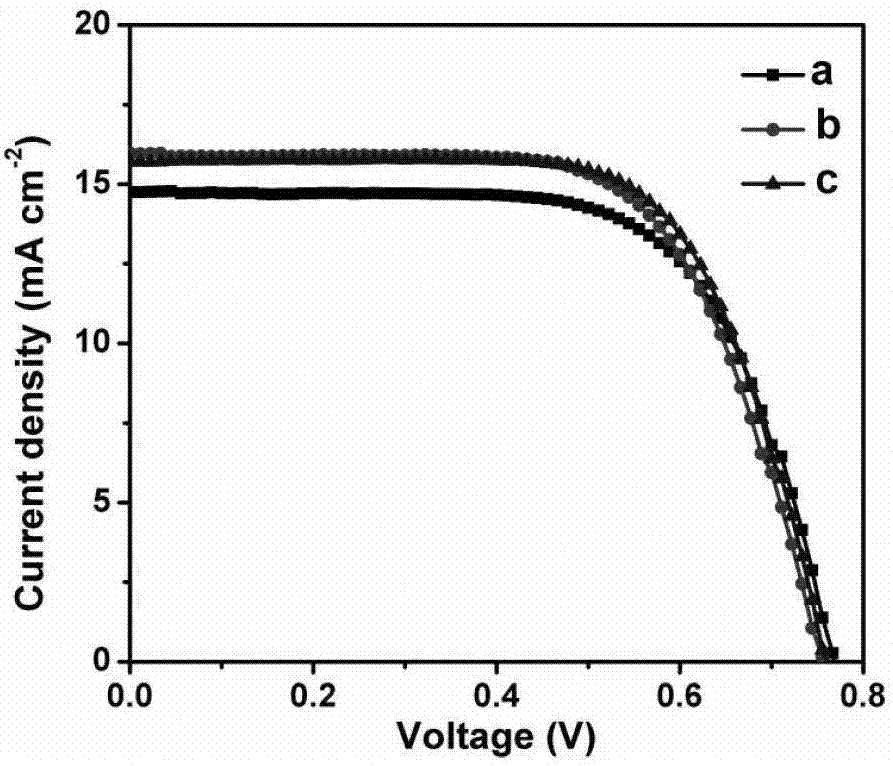A kind of graphene/polyaniline nanorod array composite material and its preparation method and application
A nanorod array and composite material technology, applied in the field of graphene/polyaniline nanorod array composite materials and their preparation, can solve the problem of limiting the electrocatalytic activity and conductivity of materials, limiting electrochemical electron transport and mass transfer, and lack of orientation. It can achieve the effect of high electrocatalytic activity and conductivity, high photoelectric conversion efficiency and low cost.
- Summary
- Abstract
- Description
- Claims
- Application Information
AI Technical Summary
Problems solved by technology
Method used
Image
Examples
Embodiment 1
[0036] Add 10 mg of graphite oxide prepared by the traditional Hummers method to 15 ml of 1mol / L perchloric acid solution, crush the cells and ultrasonically disperse for 20 minutes; pipette 150 μL of aniline monomer solution into the above dispersion, and stir for 30 minutes to obtain a uniform mixture the mixed solution; transfer the mixed solution to a low-temperature reactor, and continue to stir for 30 minutes at -5°C; take 230 mg of ammonium persulfate and add it to 6 ml of 1mol / L perchloric acid solution, and after it is completely dissolved, add it dropwise to the above mixed solution , continue to stir at -5°C, and react for 20 hours; the obtained product is suction filtered, washed with ethanol and secondary water for 2 to 3 times respectively, to obtain a graphite oxide / polyaniline array composite; transfer the above composite to the reaction kettle Add 15ml of 0.1mol / L sodium borohydride aqueous solution, react at 60°C for 3.5h, filter the obtained product with suct...
Embodiment 2
[0040] Add 12 mg of graphite oxide prepared by the traditional Hummers method to 20 ml of 1mol / L perchloric acid solution, crush the cells and ultrasonically disperse for 30 minutes; pipette 150 μL of aniline monomer solution into the above dispersion, and stir for 30 minutes to obtain a uniform mixture the mixed solution; transfer the mixed solution to a low-temperature reactor, and continue to stir for 30 minutes at -10°C; take 200 mg of ammonium persulfate and add it to 5 ml of 1mol / L perchloric acid solution, and after it is completely dissolved, add it dropwise to the above mixed solution , continue to stir at -10°C, and react for 24 hours; the obtained product is suction filtered, washed with ethanol and secondary water for 2 to 3 times respectively, to obtain a graphite oxide / polyaniline array composite; transfer the above composite to the reaction kettle Add 20ml of 0.1mol / L sodium borohydride aqueous solution, react at 80°C for 3h, filter the obtained product with suct...
Embodiment 3
[0044] Add 12 mg of graphite oxide prepared by the traditional Hummers method to 15 ml of 1mol / L perchloric acid solution, crush the cells and ultrasonically disperse for 30 minutes; pipette 120 μL of aniline monomer solution into the above dispersion, and stir for 30 minutes to obtain a uniform mixture mixed solution; transfer the mixed solution to a low-temperature reactor, and continue to stir for 30 minutes at -10°C; take 180 mg of ammonium persulfate and add it to 5 ml of 1mol / L perchloric acid solution, and after it is completely dissolved, add it dropwise to the above mixed solution , continue to stir at -10°C, and react for 24 hours; the obtained product is suction-filtered, and washed with ethanol and secondary water for 2-3 times respectively to obtain a graphite oxide / polyaniline array composite.
[0045] The complex reduction steps are the same as in Example 2, and the counter electrode preparation steps are the same as in Example 1.
[0046] This counter electrode...
PUM
| Property | Measurement | Unit |
|---|---|---|
| energy conversion efficiency | aaaaa | aaaaa |
| energy conversion efficiency | aaaaa | aaaaa |
| energy conversion efficiency | aaaaa | aaaaa |
Abstract
Description
Claims
Application Information
 Login to View More
Login to View More - R&D
- Intellectual Property
- Life Sciences
- Materials
- Tech Scout
- Unparalleled Data Quality
- Higher Quality Content
- 60% Fewer Hallucinations
Browse by: Latest US Patents, China's latest patents, Technical Efficacy Thesaurus, Application Domain, Technology Topic, Popular Technical Reports.
© 2025 PatSnap. All rights reserved.Legal|Privacy policy|Modern Slavery Act Transparency Statement|Sitemap|About US| Contact US: help@patsnap.com



